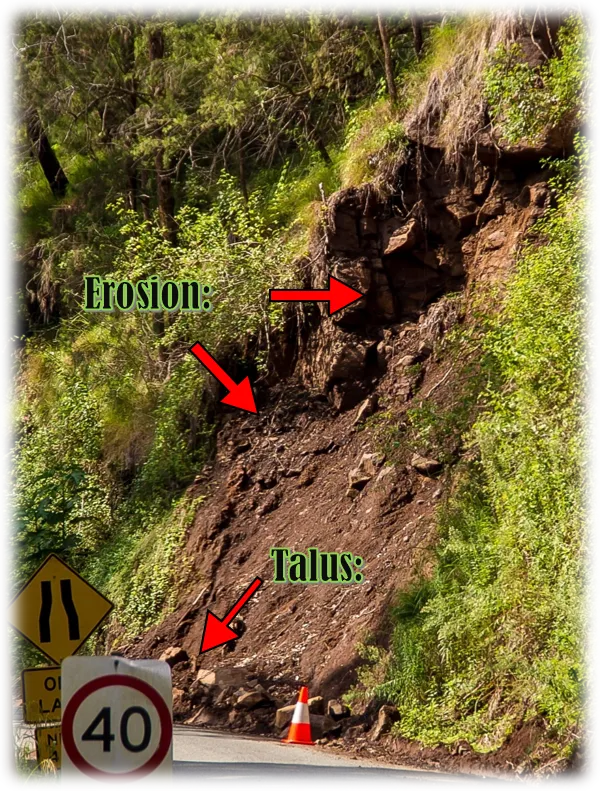1.1 Sedimentary Rock Part I.
Three Types of Rocks on Earth:
1. Igneous rock is like a rock superhero! It is formed when hot molten material called magma or lava cools down and hardens. It can happen deep underground or on the Earth's surface. Igneous rocks have crystals and can be assorted colors and shapes. They are super cool!
2. Metamorphic rock changes through a process called metamorphism. It happens when existing rocks are exposed to high heat and pressure. These intense conditions cause minerals to rearrange, forming new crystals and changing the rock's texture and appearance. It is like a rock going through a transformation! All it takes is the right conditions for this to transpire rapidly!
3. Sedimentary Rocks are the accumulation, compaction, and cementation of sediments, made up of particles derived from the erosion and weathering of pre-existing rocks or organic matter.
Sedimentary Rocks:

Geologists categorize sedimentary rocks based upon how the layer is made as well as identifying the type of rock first.
Subscribe!
5.99 mo. To watch videos!
Unlock all features!
We have sent you an email with instructions to reset your password.
You have successfully changed your password. You can now log in.
New accounts are reviewed by the administrator. We will send you an email once your account is approved.
Types of Sedimentary Rocks:
There are three types of sedimentary rocks:
1. Clastic: sandstone, shale, and breccia, and *conglomerate (*Conglomerate: meaning that it is made of rounded pebbles and sand that is usually held together (cemented) by silica, calcite, or iron oxide. This type of stone is a lot like sandstone, but the particles of rock are rounded, or angular gravel rather than sand.)
2. Chemical: This would be chert, flint, some dolomites, some limestones and sandstone, rock salt, and gypsum. They are formed by minerals in water due to chemical reactions.
3. Organic: This would include coal, and some limestone formed from shells and skeletons of tiny creatures and animals as well as plant debris that have been broken down.
Composition of sedimentary rock:
These rocks reveal a wide range of textures and compositions, depending on the type of sediments involved. Examples of common sedimentary rocks include sandstone, limestone, shale, and conglomerate.
• Sandstone is composed of sand-sized particles.
• Limestone is composed of calcium carbonate derived from shells or coral.
• Shale consists of fine-grained particles, and conglomerate contains a mix of rounded pebbles and larger fragments.
Sedimentary rocks often preserve valuable information about Earth's history and past environments. Fossils, for instance, are commonly found in sedimentary rocks!
Additionally, sedimentary rock layers, or strata, can provide insights into geological events, Noah’s flood catastrophe, and the movement of continents.
 Have you ever ridden down the highway and noticed the chiseled down cliff sides from the construction whittling away at a steep grade so vehicles could pass through?
Have you ever ridden down the highway and noticed the chiseled down cliff sides from the construction whittling away at a steep grade so vehicles could pass through?
If you look closely at the base of those large cliffs, you might see a lot of talus lying on the ground in heaps.
What is talus?
Talus is loose rocks that erode and fall from the cliff edge down to the lowest part of the decline. They tumble to the ground below as they break off this is called erosion. Weathering over time, the hot sun, water cascading over it, beating on it in heavy rains, and freezing and thawing breaks the rocks up into pieces. If you see talus, (scaly type large chips of rocks) it comes from sedimentary rock.
It is also the most common type of rock you will see.
What is Sedimentary Rock?
Sedimentary rock is particles of matter that have been ripped up, redistributed, and packed down to form rock layers. You will find sandstone, limestone, shale, and coal particles called “sediments”. Pieces that have all jammed packed together to form the rock layers that we see around us.
These layers, made up of different kinds of stone, were all formed under water when they were not hard, but pliable, and moldable.

What Caused Sedimentary Rock Layers?
How sedimentary rock is formed:
Sedimentary rocks are formed in varying environments: rivers, lakes, oceans, and deserts, where the processes of erosion, transportation, deposition, and lithification took place and in the right conditions, we have observed by researching Mt. St. Helen’s eruption that all it takes are the right conditions for it to happen surprisingly rapidly!
As sediments settle and accumulate, they undergo compaction, which squeezes out water and reduces pore space between particles. This compaction, combined with the presence of minerals or cementing agents, causes the sediment to solidify and harden creating sedimentary rock.
Now that we know what sediments are, we need to ask ourselves what caused jumbled up pieces of different kind of rocks covering so much of the earth’s surface? Geological processes shows great indication of serious floodwaters! This flood would have been of massive global proportions! Warm, even volcanic raging waters caused the rocks to jumble together tossing them around into tiny bits and distributing them all over the place leaving them to dry.
When rock goes from soft and pliable to solid and hard, Geologist call this “lithify.”
Imagine if you took solid crackers, cookies, and bread and put it all in a blender and added water enough to create a soup. Then you pour it all out to dry in the sun. It wouldn’t take long periods of time for these things to harden and dry up, and start to crack and crumb, and fall apart.
If they had never been jumbled in the blender so with water, they would have never combined into one another, and been a crumby mess, would they?
Where to find sedimentary rock:

We find sedimentary rocks all over the world! If you love Geology you can discover your own sedimentary rock by going on a walk and looking at the rock layers in a cliff, or hillside. (Think rock pieces). It is not very hard to find a slope with rock pieces that are sliding down the hill in tiny shards. This is what would be called sedimentary rocks!
Have you ever seen a sign that says watch for falling rock? Well, you never know when the sedimentary rock might suddenly slide down and give you a tumbling visit! This rock is not solid and sturdy like granite. (Granite can endure a lot of pressure and does not flake or fall to pieces like sedimentary rocks.)
What Sedimentary Rocks Teach Us:
God tells us plainly in his Word that a flood covered the whole entire face of the earth.
It is important to understand why it is so important to take God at His word! The way we interpret the world around us reflects from our position of beliefs!
If we refuse to believe a flood covered the earth like the Bible tells us, then we no longer believe that God judged evil. Remember that’s why God sent a flood? We talk about the flood in depth in the Theology section.
Another interesting thing to consider is that the reason evolutionists do not believe in a global flood is because it points to God and his righteousness, man’s sinfulness and need for a Savior. It reminds them of God’s perfection, and moral law that they fall short of, and the judgment of God. God cannot close his eyes to evil and pretend it is not there. One day, he will judge every man whether they have put their trust in his salvation to forgive them of sin, or whether they reject Him. To even think they will answer to a perfect God is a scary thought! Nobody thinks they need God. It takes humility and honesty to realize we need Jesus. Some are too proud to admit they need salvation from their evil ways.
This is probably the largest true reason many believe in evolution because they think it will take away the truth that God is real. But deep inside. Many know it is only a cover-up excuse to not trust Jesus.







